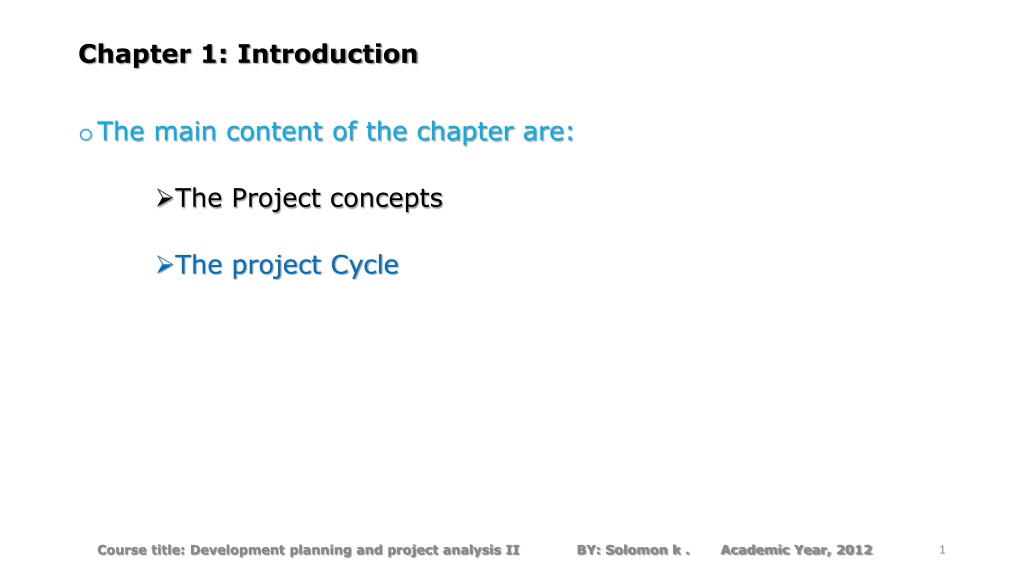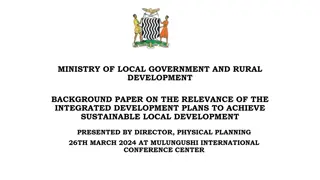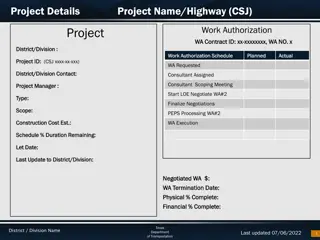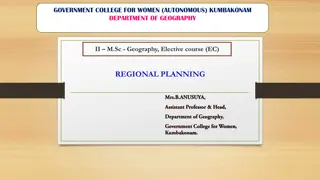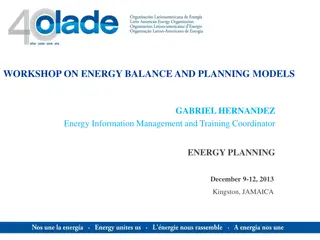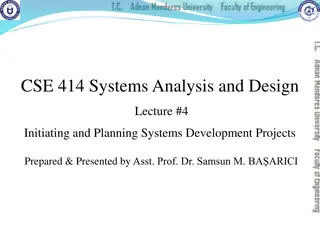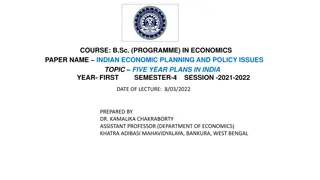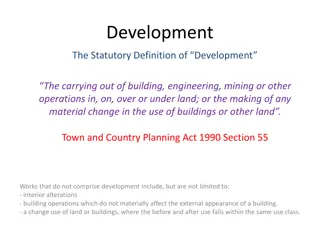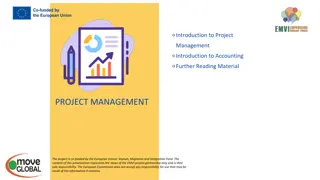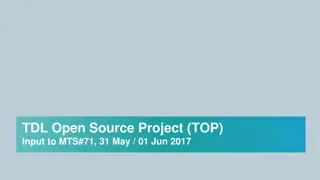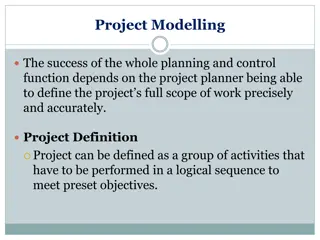Understanding Project Concepts and Characteristics in Development Planning
This chapter introduces the fundamental concepts and characteristics of projects, emphasizing the importance of understanding the project cycle and objectives. It explains how projects involve planning and executing activities to create unique products or services, investing resources for future benefits, and meeting specific objectives within a defined timeframe. The text highlights the temporary nature and common features of projects, such as having a distinct purpose and being developed through progressive elaboration.
Download Presentation

Please find below an Image/Link to download the presentation.
The content on the website is provided AS IS for your information and personal use only. It may not be sold, licensed, or shared on other websites without obtaining consent from the author. Download presentation by click this link. If you encounter any issues during the download, it is possible that the publisher has removed the file from their server.
E N D
Presentation Transcript
Chapter 1: Introduction oThe main content of the chapter are: The Project concepts The project Cycle Course title: Development planning and project analysis II BY: Solomon k . Academic Year, 2012 1
Cont, The objectives of this chapter is to familiarizes the students with: D/t concepts of the Project The project Cycle Course title: Development planning and project analysis II BY: Solomon k. Academic Year, 2012 2
The Project concepts Project is the group of activities that are planned and executed in a certain sequence to create a unique product and services. Or It is a complex set of economic activities in which scarce resources are committed in expectation of benefits that exceed the costs of resources consumed. Course title: Development planning and project analysis II BY: s olomon k Academic Year, 2012 3
Cont..., A project is also defined as atemporary endeavor undertaken to create or provide a unique Goods or Services. A project involves the investment of scarce resources (physical, financial, and human) in the expectation of futurebenefits. It is a group of tasks performed in a definable time period in order to meet a specific set of objectives. Course title: Development planning and project analysis II BY: s k Academic Year, 2012 4
Cont..., Projects are said to be desirable if their benefits are greater than the costs incurred on them. Projects can be: public, private, small, large, agricultural, industrial, etc. Course title: Development planning and project analysis II BY: s k. Academic Year, 2012 5
Cont., Project is a conversion process which serves in transforming inputs into outputs. Constraint Input Project Output Mechanism Course title: Development planning and project analysis II BY: s k Academic Year, 2012 6
Basic characteristics of a project Regardless of the size of a project, projects have common characteristics. Some of these characteristics are: A project has a unique purpose A project is temporary. A project is developed using progressive elaboration. Course title: Development planning and project analysis II BY: s k. Academic Year, 2012 7
Cont., A project requires resources, often from various areas. A project should have a primary customer or sponsor. Have definite location and target group (beneficiaries). A project involves uncertainty. Course title: Development planning and project analysis II BY: s k Academic Year, 2012 8
Classification of project /capital investment/ Projects may be classified into: Development projects Business projects Course title: Development planning and project analysis II BY: s k Academic Year, 2012 9
Difficulties of capital investment Although capital investments are so important, they are not without difficulties. These difficulties may arise from two major sources; namely, Measurement problems Uncertainty :It is impossible to predict exactly what will happen in the future. Course title: Development planning and project analysis II BY: s k Academic Year, 2012 10
Project success criteria (Parameters) During a project s life, project management should give attention to three basic parameters: quality, cost and time. A successfully managed project is one that is completed at the specified level of quality; on or before the deadline; and within the budget. Whatever its size, a project s success is based on these three main criteria. Course title: Development planning and project analysis II BY: Academic Year, 2012 11
Cont..., Course title: Development planning and project analysis II BY: s k. Academic Year, 2012 12
Cont..., Therefore, project will suppose to be successful if it: Delivers the outcome with an agreed upon quality. Does not overrun its end date. Remains within budget (cost of resources). Course title: Development planning and project analysis II BY: s k. Academic Year, 2012 13
Cont..., In addition, client satisfaction will indicate success and possibility for replication or sustainability. Generally, to create a successful project, a project manager must consider; Scope: What work will be done or what unique product, service? Time: How long should it take to complete the project? What is the project s schedule? Course title: Development planning and project analysis II BY:s k Academic Year, 2012 14
Cont..., Cost: What should it cost to complete the project? Or What is the project s budget? Quality: How good does the quality of the products or services need to be? What do we need to do to satisfy the customer? Risk: How much risks are we willing to accept on the project? Course title: Development planning and project analysis II BY: s k. Academic Year, 2012 15
Project and Program Course title: Development planning and project analysis II BY: s k. Academic Year, 2012 16
1.2 The project Cycle Project cycle refers to the various stages through which project planning proceeds from the inception to implementation. Or, it is the life cycle through which a project advances from infancy to maturity. The main features of this cycle are information gathering, analysis, and decision making. Course title: Development planning and project analysis II BY: s k. Academic Year, 2012 17
See the following diagram: Identification Evaluation Preparation Implementation Appraisal Figure 1.1: project cycle (Source: Baum 1978) Course title: Development planning and project analysis II BY: s k. Academic Year, 2012 18
1. Project identification In this stage, projects that can contribute towards achieving the specified objectives are identified (listed). Project ideas may come from: Local leaders Entrepreneurs Government policy and plans Replication of successful project tested elsewhere Other sources Course title: Development planning and project analysis II BY: s k. Academic Year, 2012 19
2. Project preparation and analysis Once project ideas have been identified the process of project preparation and analysis starts. Project preparation must cover the full range of technical, institutional, economic, and financial conditions necessary to achieve the project s objective. Critical element of project preparation is identifying and comparing technical and institutional alternatives for achieving the project s objectives. Course title: Development planning and project analysis II BY: s k Academic Year, 2012 20
Cont, D/t alternatives may be available and therefore, resource endowment (labor or capital) would have to be considered in the preparation of projects. It involves generally two steps: Pre-feasibility studies Feasibility studies Course title: Development planning and project analysis II BY: s k. Academic Year, 2012 21
Cont, Pre-feasibility Study At the pre-feasibility study stage the analyst obtains approximate valuation of the major components of the projectscosts and benefits. Using this preliminary data a preliminary financial and economic analysis will be conducted. Course title: Development planning and project analysis II BY: s k. Academic Year, 2012 22
Cont, If the project appear viable form in this preliminary assessment, the analysis will be carried to the feasibly stage. Feasibility Study The major d/ce b/n the pre-feasibility and feasibility studies is the amount of work required in order to determine whether a project is likely to be viable or not. Course title: Development planning and project analysis II BY: s k. Academic Year, 2012 23
Cost, If the preliminary screening suggests that the project is prima facie worthwhile, a detailed analysis of the marketing, technical, financial, economic, and ecological aspects will undertaken. The focus of this phase of capital budgeting is on gathering, preparing, and summarizing relevant information about various project proposals, which are being considered for inclusion in the capital investment. Course title: Development planning and project analysis II BY: s k. Academic Year, 2012 24
Cont, At this stage a team of specialists (i.e. engineers, economists, scientists, sociologists & etc.) will need to work together. At this stage more accurate data need to be obtained and the final product of this stage is a feasibility report. The feasibility report should contain the following elements/ aspect: Course title: Development planning and project analysis II BY: s k Academic Year, 2012 25
1. Technical Aspects This may include the works of engineers, soil scientists and agronomists in case of, say, agricultural projects. Is concerned with the technology of production and processing. Poor technical analysis would eventually lead to spurious cost and benefit estimates. Therefore, coordination of creative, committed and competent specialists from d/t fields are needed. Course title: Development planning and project analysis II BY: s k. Academic Year, 2012 26
2. Market Aspects This aspect analysis needs to ensure the existence of effective demand at remunerative price. Similar arrangements need to be done on the input side too (input supplies). Course title: Development planning and project analysis II BY: s k. Academic Year, 2012 27
3. Institutional-Organizational-Managerial Aspects This is about detail analysis of project organization and management. The project should be implemented by competent, responsible and committed managers. Course title: Development planning and project analysis II BY: s k. Academic Year, 2012 28
4.Financial Aspects Financial analysis seeks to determine whether the proposed project will be financially viable or not. This analysis will be the basis for evaluating the project profitability. Project profitability depends on a comparison of costs versus revenues. Course title: Development planning and project analysis II BY: s k. Academic Year, 2012 29
5. Economic Aspects This is about the social costs and benefits of a project, which may often be different from its monetary or financial costs, and benefits. The financial analysis views the project from the participants (or owners) point of view, while the economic analysis form the society s point of view. Course title: Development planning and project analysis II BY: s k. Academic Year, 2012 30
6. Social Aspects This is about examine the broader social implications of the proposed project. The social aspect analysis should address the income distribution implications of a project and aspect of employment opportunities & etc. Course title: Development planning and project analysis II BY: s k. Academic Year, 2012 31
7. Environmental aspect analysis In recent years environmental concerns have assumed a great deal of significance. This assessment is about effect of a project on the world of animals, plants, water, air, and humans existing in the project area. Course title: Development planning and project analysis II BY: s k. Academic Year, 2012 32
3. Project Appraisal A The prime objective of project appraisal should be to identify the weaknesses and identify means of strengthening it adequately to ensure final success of the project. The main objective is then to improve the project. Course title: Development planning and project analysis II BY: s k. Academic Year, 2012 33
4. Project implementation It is the stage at which the conclusions are reached & decisions made are put into action. Some of the major activities in during project implementation phase include: Detailed designs; Tender documents are prepared; Bids are evaluated, Course title: Development planning and project analysis II BY: s k. Academic Year, 2012 34
Cont, Contracts are signed; workers are hired, training; Materials are moved to sites & etc. 5. Project Evaluation Implementation phase is followed by supervision and follow up. The execution of the project should be supervised closely and progress should be reported regularly. Course title: Development planning and project analysis II BY: s k. Academic Year, 2012 35
Cont, Project evaluation is a monitoring (checking) activity in order to: Find out how things are going Encourage the project team Check that promised resources are in fact working on project tasks Rapidly learn about concerns and difficulties Course title: Development planning and project analysis II BY: s k. Academic Year, 2012 36
Cont, Show concern for the success of the project Take corrective action if things go wrong The project management, the sponsoring agency, or other bodies may do the evaluation. Course title: Development planning and project analysis II BY: s k. Academic Year, 2012 37
